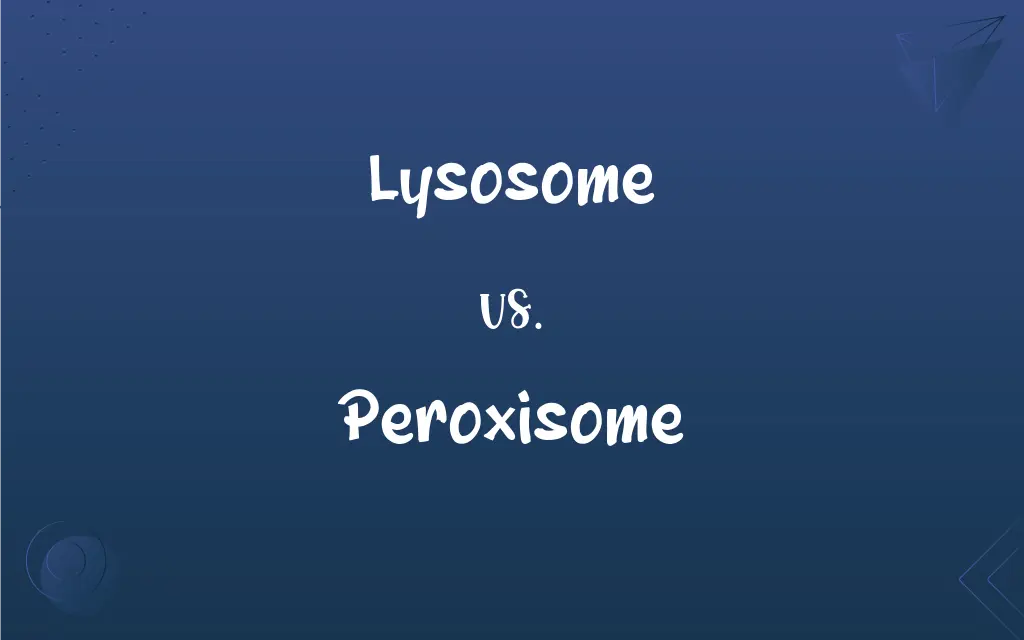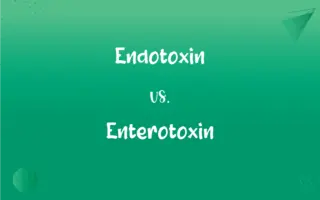Lysosome vs. Peroxisome: What's the Difference?
Edited by Aimie Carlson || By Janet White || Published on December 27, 2023
Lysosomes are cellular organelles containing digestive enzymes, while peroxisomes contain enzymes for oxidative reactions.

Key Differences
Lysosomes are specialized organelles in eukaryotic cells that digest cellular waste and foreign material using enzymes. Peroxisomes, in contrast, are involved in the breakdown of very long chain fatty acids through beta-oxidation.
Lysosomes function as the cell's waste disposal system, degrading worn-out organelles and macromolecules. Peroxisomes, however, play a key role in detoxifying substances, like alcohol, in the liver.
The enzymes in lysosomes work best in acidic environments, which is maintained within these organelles. Peroxisomes contain enzymes that produce and degrade hydrogen peroxide, a byproduct of their metabolic reactions.
Lysosomes are formed from the Golgi apparatus, while peroxisomes self-replicate by fission or are formed de novo.
In terms of genetic diseases, defects in lysosomal enzymes can lead to lysosomal storage diseases. Peroxisomal disorders, on the other hand, often involve abnormalities in peroxisome biogenesis or enzyme functions.
ADVERTISEMENT
Comparison Chart
Function
Digests cellular waste and foreign material
Participates in lipid metabolism and detoxification
Enzyme Environment
Operates in acidic conditions
Produces and degrades hydrogen peroxide
Origin
Formed from Golgi apparatus
Self-replicates or formed de novo
Role in Disease
Lysosomal storage diseases
Peroxisomal disorders
Key Metabolic Process
Breakdown of macromolecules
Beta-oxidation of fatty acids
ADVERTISEMENT
Lysosome and Peroxisome Definitions
Lysosome
A membrane-bound organelle with digestive enzymes.
Lysosomes break down cellular debris.
Peroxisome
Involved in lipid metabolism.
Peroxisomes break down long-chain fatty acids.
Lysosome
Containing acid hydrolases for digestion.
Lysosomes are essential for recycling cellular components.
Peroxisome
Contains catalase for hydrogen peroxide decomposition.
Peroxisomes neutralize toxic byproducts.
Lysosome
A part of the endomembrane system.
Lysosomes originate from the Golgi apparatus.
Peroxisome
An organelle with oxidative enzymes.
Peroxisomes detoxify harmful substances.
Lysosome
A cell's waste disposal system.
Lysosomes digest damaged organelles.
Peroxisome
Key in producing and degrading hydrogen peroxide.
Peroxisomes balance reactive oxygen species.
Lysosome
Involved in autophagy within cells.
Lysosomes help in cellular renewal.
Peroxisome
Self-replicating organelles in cells.
Peroxisomes proliferate in response to metabolic needs.
Lysosome
A membrane-bound organelle in the cytoplasm of most cells containing various hydrolytic enzymes that function in intracellular digestion.
Peroxisome
A cell organelle containing a large number of enzymes, including catalase and oxidase, that break down long-chain fatty acids and other organic molecules. The hydrogen peroxide produced by these reactions is also broken down within the peroxisome.
Lysosome
(cytology) An organelle found in all types of animal cells which contains a large range of digestive enzymes capable of splitting most biological macromolecules.
Peroxisome
(cytology) An intracellular organelle found in all eukaryotes (except Archezoa) which is the source of the enzymes that catalyze the production and breakdown hydrogen peroxide, and are responsible for the oxidation of long-chain fatty acids.
Lysosome
An organelle found in the cytoplasm of most cells (especially in leukocytes and liver and kidney cells)
FAQs
What is a lysosome?
A cell organelle containing digestive enzymes.
What is a peroxisome?
An organelle with enzymes for lipid metabolism and detoxification.
What disorders are associated with peroxisomes?
Peroxisomal disorders, often related to biogenesis or enzyme function.
How do lysosomes function?
By breaking down cellular waste using acidic enzymes.
Can lysosomes digest foreign substances?
Yes, they can break down foreign material ingested by the cell.
Why are peroxisomes important in the liver?
They detoxify substances like alcohol.
How do peroxisomes protect cells?
By neutralizing harmful oxidative byproducts.
What is the main role of peroxisomes?
Peroxisomes are involved in fatty acid metabolism and hydrogen peroxide degradation.
Where do lysosomes originate?
From the Golgi apparatus.
What's unique about peroxisomal enzymes?
They produce and degrade hydrogen peroxide.
How are peroxisomes formed?
They can self-replicate or be formed de novo.
What is the role of lysosomes in immunity?
They help destroy pathogens ingested by immune cells.
Do lysosomes have a specific pH?
Yes, they function in an acidic environment.
What happens if lysosomes malfunction?
It can lead to the accumulation of undigested substances.
What is autophagy in relation to lysosomes?
The process where lysosomes degrade and recycle cell components.
Are peroxisomes larger than lysosomes?
Their size can vary, but they are generally similar in size.
How do lysosomal enzymes reach lysosomes?
They are transported there from the Golgi apparatus.
Are lysosomes involved in any diseases?
Yes, lysosomal storage diseases are caused by enzyme defects.
What role do peroxisomes play in aging?
They may influence aging by managing oxidative stress.
Can peroxisomes change in number?
Yes, they can proliferate in response to cellular needs.
About Author
Written by
Janet WhiteJanet White has been an esteemed writer and blogger for Difference Wiki. Holding a Master's degree in Science and Medical Journalism from the prestigious Boston University, she has consistently demonstrated her expertise and passion for her field. When she's not immersed in her work, Janet relishes her time exercising, delving into a good book, and cherishing moments with friends and family.
Edited by
Aimie CarlsonAimie Carlson, holding a master's degree in English literature, is a fervent English language enthusiast. She lends her writing talents to Difference Wiki, a prominent website that specializes in comparisons, offering readers insightful analyses that both captivate and inform.































































